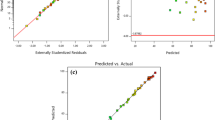Abstract
Here, we report for the first time the direct and simultaneous determination of kinetic and energetic parameters of Cr(VI) sorption on chemically modified fish scales (GA-scale) using solution microcalorimetry. Characterization has suggested that electrostatic interactions between scales collagen positive charges and chromate negative charges constitute the majority of the interactions. The microcalorimetric kinetic data of Cr(VI) sorption on GA-scale were successful adjusted to a three-parameter exponential function. The enthalpies of Cr(VI) sorption on GA-scale are highly exothermic (from −226.43 to −183.79 kJ mol−1), and Cr(VI) interaction energies decrease as initial Cr(VI) in solution increases. The kinetic and thermodynamic from solution microcalorimetry results suggest that the interactions GA-scale/Cr(VI) occur mainly by surface reactions. The maximum adsorption capacity of GA-scale for Cr(VI) was found to be comparable with some commercial adsorbent samples.





Similar content being viewed by others
References
Miretzky P, Cirelli AF. Cr(VI) and Cr(III) removal from aqueous solution by raw and modified lignocellulosic materials: a review. J Hazard Mater. 2010;180:1–19.
Srividya K, Mohanty K. Biosorption of hexavalent chromium from aqueous solutions by Catla catla scales: equilibrium and kinetics studies. Chem Eng J. 2009;155:666–73.
McFarlane NL, Wagner NJ. Calorimetric study of the adsorption of poly(ethylene oxide) and poly(vinylpyrrolidone) onto cationic nanoparticles. Langmuir. 2010;26:6262–7.
Chowdhry BZ, Beezer AE, Greenhow EJ. Analysis of drugs by microcalorimetry: isothermal power-conduction calorimetry and thermometric titrimetry. Talanta. 1983;30:209–43.
Arakaki LNH, Diniz JS, Silva ALP, Augusto Filha VLS, Fonseca MG, Espínola JGP, Arakaki T. Thermal study of chelates of Co(II), Cu(II), Ni(II), Cr(III), Mo(III), and Fe(III) with bis(acetylacetone)ethylenediimine on activated silica gel surface. J Therm Anal Calorim. 2009;97:377–82.
Dizge N, Keskinler B, Tanriseven A. Covalent attachment of microbial lipase onto microporous styrene–divinylbenzene copolymer by means of polyglutaraldehyde. Colloids Surf B. 2008;66:34–8.
Vieira EFS, Cestari AR, Silva RG, Pinto AA, Miranda CR, Conceição ACF. Use of calorimetry to evaluate cement slurry resistance to the attack of acid solutions. Thermochim Acta. 2004;419:45–9.
Vieira EFS, da Costa LP, Cestari AR. Preparation and characterization of polyalginate-glutaraldehyde membranes-swelling analysis by microcalorimetry and adsorption kinetics of cationic dye. J Appl Polym Sci. 2010;118:857–65.
Pati F, Adhikari B, Dhara S. Isolation and characterization of fish scale collagen of higher thermal stability. Bioresour Technol. 2010;101:3737–42.
Liu WT, Zhang Y, Li GY, Miao YQ, Wu XH. Structure and composition of teleost scales from snakehead Channa argus (Cantor) (Perciformes: Channidae). J Fish Biol. 2008;72:1055–67.
Migneault I, Dartiguenave C, Bertrand MJ, Waldron KC. Glutaraldehyde: behavior in aqueous solution, reaction with proteins, and application to enzyme crosslinking. Biotechniques. 2004;37:790–802.
Sardohan T, Kir E, Gulec A, Cengeloglu Y. Removal of Cr(III) and Cr(VI) through the plasma modified and unmodified ion-exchange membranes. Sep Purif Technol. 2010;74:14–20.
Tanriseven A, Zehra O. A novel method for the immobilization of glucoamylase onto polyglutaraldehyde-activated gelatin. Biochem Eng J. 2008;39:430–4.
Nadeem R, Ansari TM, Khalid AM. Fourier transform infrared spectroscopic characterization and optimization of Pb(II) biosorption by fish (Labeo rohita) scales. J Hazard Mater. 2008;156:64–73.
Yongli C, Xiufang Z, Yandao G, Nanming Z, Tingying Z, Xinqi S. Conformational changes of fibrinogen adsorption onto hydroxyapatite and titanium oxide nanoparticles. J Colloid Interface Sci. 1999;214:38–45.
Bella J, Brodsky B, Bermanl HM. Hydration structure of a collagen peptide. Structure. 1995;3:893–906.
Mack C, Wilhelm B, Duncan JR, Burgess JE. Biosorption of precious metals. Biotechnol Adv. 2007;25:264–71.
Panczyk T, Warzocha TP, Szabelski P, Rudzinski W. Kinetic adsorption energy distributions of rough surfaces: a computational study. Langmuir. 2008;24:8719–25.
Carvalho WA, Zanin CICB, Zanutelo C, Figueiredo FCA, Cestari AR, Vieira EFS. Cadmium(II) adsorption by activated carbon: batch studies and reversibility. Int J Environ Technol Manag. 2010;12:257–76.
Kotas J, Stasicka Z. Chromium occurrence in the environment and methods of its speciation. Environ Pollut. 2000;107:263–83.
Wadso I. Trends in isothermal microcalorimetry. Chem Soc Rev. 1997;26:79–86.
Moreno-Piraján JC, Tirano J, Salamanca B, Giraldo L. Activated carbon modified with copper for adsorption of propanethiol. Int J Mol Sci. 2010;11:927–42.
Cestari AR, Vieira EFS, Matos JDS, dos Anjos DSC. Determination of kinetic parameters of Cu(II) interaction with chemically modified thin chitosan membranes. J Colloid Interface Sci. 2005;285:288–95.
Cotoruelo LM, Marques MD, Rodríguez-Mirasol J, Cordero T, Rodríguez JJ. Sorption of aromatic compounds on activated carbons from lignin: kinetic study. Ind Eng Chem Res. 2007;46:2853–60.
Lazaridis NK, Karapantsios TD, Georgantas D. Kinetic analysis for the removal of a reactive dye from aqueous solution onto hydrotalcite by adsorption. Water Res. 2003;37:3023–33.
Kadirvelu K, Faur-Brasquet C, Le Cloirec P. Removal of Cu(II), Pb(II), and Ni(II) by adsorption onto activated carbon cloths. Langmuir. 2000;16:8404–9.
Wadsö I. Characterization of microbial activity in soil by use of isothermal microcalorimetry. J Therm Anal Calorim. 2009;95:843–50.
Navrotsky A. Energetics of oxide nanoparticles. Int J Quantum Chem. 2009;109:2647–57.
Selomulya C, Meeyoo V, Amal R. Mechanisms of Cr(VI) removal from water by various types of activated carbons. J Chem Technol Biotechnol. 1999;74:111–22.
Hu Z, Lei L, Li Y, Ni Y. Chromium adsorption on high-performance activated carbons from aqueous solution. Sep Purif Technol. 2003;31:13–8.
Dakiky M, Khamis M, Manassra A, Mereb M. Selective adsorption of Cr(VI) in industrial wastewater using low-cost abundantly available adsorbents. Adv Environ Res. 2002;6:533–40.
Zhao N, Na W, Li J, Qiao Z, Jing C, Fei H. Surface properties of chemically modified activated carbons for adsorption rate of Cr(VI). Chem Eng J. 2005;115:133–8.
Hamadi NK, Chen XD, Farid MM, Lu MGQ. Adsorption kinetics for the removal of chromium(VI) from aqueous solution by adsorbents derived from used tyres and sawdust. Chem Eng J. 2001;84:95–105.
Acknowledgements
The authors are indebted to the Brazilian agencies CAPES and CNPq for financial support and fellowships.
Author information
Authors and Affiliations
Corresponding author
Rights and permissions
About this article
Cite this article
Moura, K.O., Vieira, E.F.S. & Cestari, A.R. The use of solution microcalorimetry to evaluate chemically modified fish scales as a viable adsorbent for heavy metals. J Therm Anal Calorim 107, 999–1005 (2012). https://doi.org/10.1007/s10973-011-1612-8
Received:
Accepted:
Published:
Issue Date:
DOI: https://doi.org/10.1007/s10973-011-1612-8




